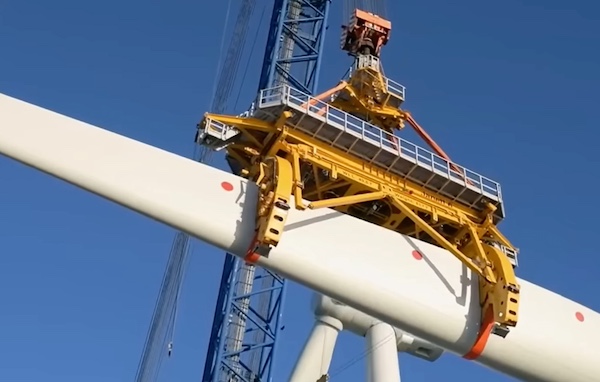
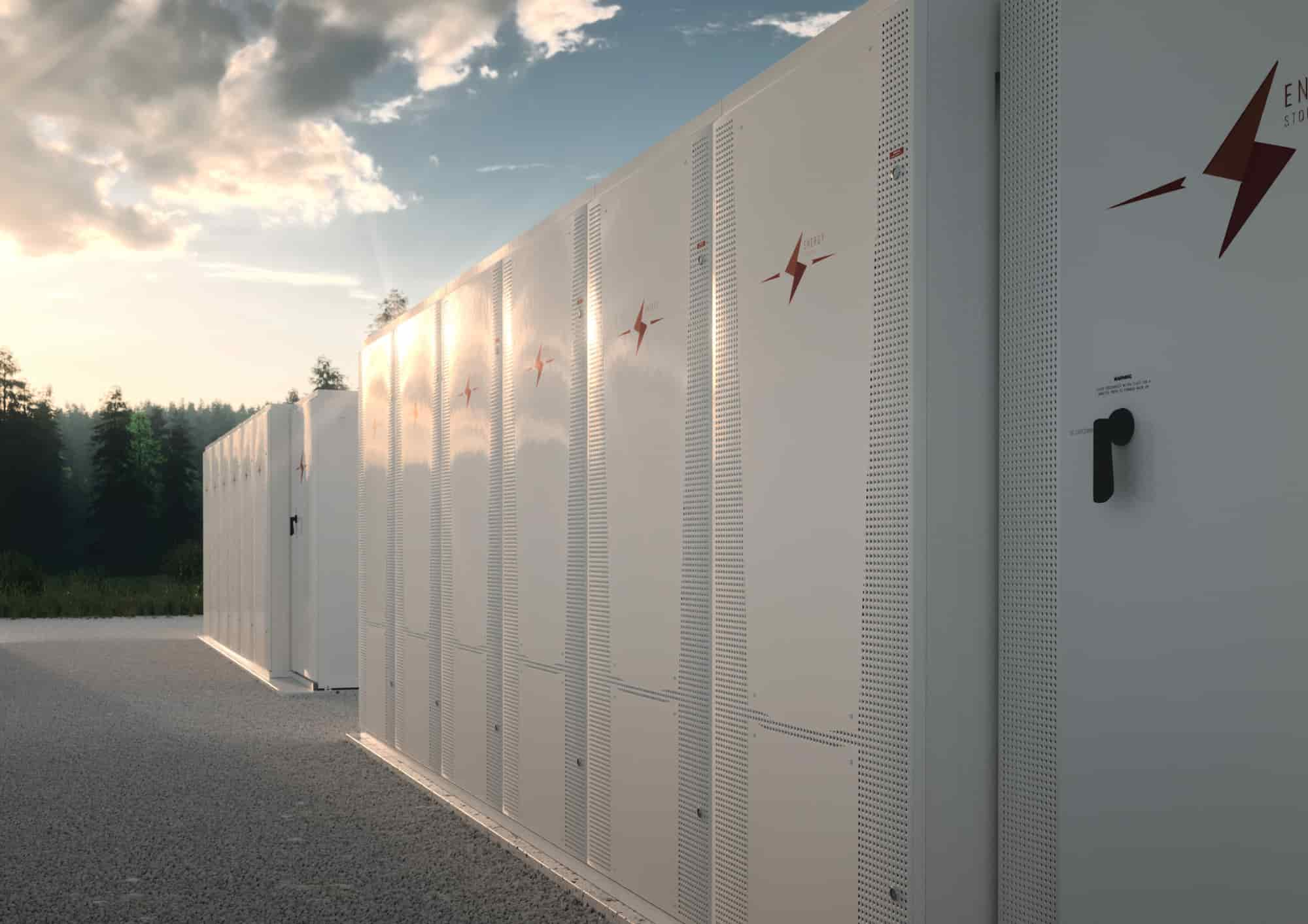
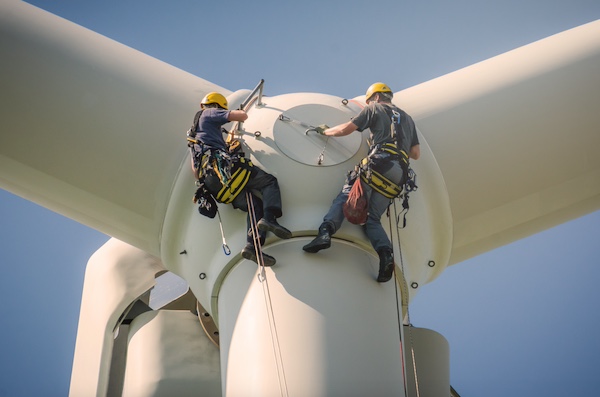

On Monday, April 22, Avondale Global Gateway (AGG) brought together global leaders engaged in the burgeoning offshore wind industry to learn more about capabilities available in South Louisiana and specifically at the massive shipping terminal, during the International Partnering Forum (IPF) hosted by Oceantic Network. Later this week, AGG will host delegations from Germany and England and the Norwegian Ambassador to display how Avondale Global Gateway is creating an environment to support Louisiana’s nascent offshore wind industry.
.jpg)
“This week’s wind conference is testament to Louisiana’s position as a key player in America’s growing wind energy industry. We are proud to display the benefits of doing business in our state to the dozens of worldwide business leaders who visited Avondale Global Gateway,” said Adam Anderson, HOST Chairman and CEO. “As we’ve seen both overseas and in the Northeast US, the offshore wind industry requires substantial amounts of high-load-bearing capacity port infrastructure to manage the transportation and handling of these massive components. Our team has experience handling the largest onshore wind components and working with Gulf Wind Technology on-site to develop solutions for the offshore market. We are excited to see what the future holds for this cutting-edge company and wind energy in Louisiana.”
Over 50 IPF participants gained insight into the offshore wind research and innovation occurring at AGG led by Gulf Wind Technology and the logistics capabilities made possible by the Mississippi River. AGG has been engaged in importing onshore wind components since 2021 and reloading the pieces back onto barges for transport up the Mississippi River to onshore wind farms in the Midwest. In 2023, Gulf Wind Technology became a tenant at AGG with the aim of launching Louisiana’s offshore wind industry. With its location at Avondale Global Gateway, GWT and similar companies can manufacture wind components at AGG then barge them down the Mississippi River to be deployed in the Gulf of Mexico through Port Fourchon.
“New Orleans and the state of Louisiana plays a key role in America’s offshore energy industry and serves as a perfect location for IPF this year, as the Gulf of Mexico continues to bolster the domestic offshore wind supply chain,” said Liz Burdock, founder and CEO of Oceantic Network. “Companies along the Gulf Coast are already hard at work building America’s next energy industry and moving to integrate new technologies like green hydrogen into offshore wind. Embracing its offshore energy past and incorporating the future of offshore wind, New Orleans and the state of Louisiana are emerging as a center of experience, expertise, innovation, and heart of this new industry.”
Avondale Global Gateway is well positioned to become a hub for offshore wind in the Gulf of Mexico, due to the all-encompassing unique value the property provides as well as the proximity to the experienced offshore workforce in the Gulf of Mexico. The property is ideal for importing large offshore wind components, storage, sub-assembly and on-site manufacturing and fabrication prior to loading offshore wind turbine components out on barges for installation in the Gulf.
“We are thrilled to welcome the largest offshore wind energy conference in the Americas to our facility at Avondale Global Gateway,” said James Martin, Gulf Wind Technology CEO. “It is incredible that industry experts from around the world are coming to share ideas and learn about the advanced scientific work happening right here in Louisiana.”
AGG has a prime location on the Mississippi River with over one mile of deep riverfront and five docks, four Gantry heavy lift cranes with up to 350 tons capacity and dual pick capabilities, 1.2 million square feet of warehouse space, and hundreds of acres of lay down storage space.
HOST | www.tparkerhost.com
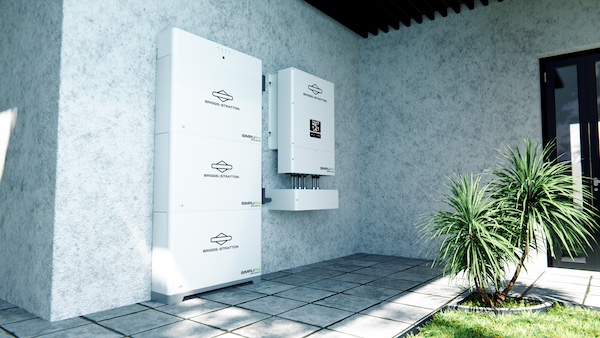
Briggs & Stratton Energy Solutions is advancing battery technology with the introduction of its next-generation SimpliPHI home battery system. Briggs & Stratton’s SimpliPHI 6.6 battery features the innovative RapidStakc onnector that includes all communications and power in one connection, allowing the batteries to easily stack on top of each other and click into place. With no wires, no pin outs, no DIP switches, a 19.95 kWh three-stack of batteries can be assembled in under five minutes. The SimpliPHI 6.6 battery is designed to pair seamlessly with both SimpliPHI and Sol-Ark inverters.
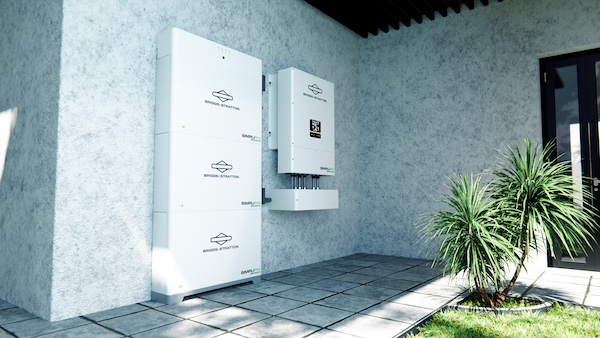
The SimpliPHI 6.6 battery was designed by installers for installers. By eliminating DIP switches and wires between batteries, the tedious and time-consuming on-site work has been removed from the installation. The RapidStak connector design prevents any chance of reverse polarity. With less cutting and termination of wires on-site, fewer tools are required. In addition, the SimpliPHI 6.6 battery is IP65 rated so it can be ground- or wall-mounted indoors or outdoors with no additional cabinets required. The mounting brackets have been designed for easy, one-person installation.
“The SimpliPHI 6.6 battery is breaking new ground and delivering on our commitment to installers,” said Tom Rugg, SVP & president, Briggs & Stratton Energy Solutions. “We’ve created a system that helps them execute installations efficiently, with fewer complications, and that allows them to be more productive and helps their bottom line. With our competitive new price point, installers can provide their customers with a premium energy storage system at an affordable price.”
The new SimpliPHI 6.6 battery delivers 6.65 kWh and can be installed in stacks of one to three. For increased power, a system can be scaled to six stacks of three with the 18 batteries delivering 119.7 kWh with maximum continuous power of 84 kW. The lithium ferro phosphate (LFP) chemistry allows for 6,000+ cycles @ 80% DoD with an end-of-life capacity of 75%. An increased discharge rate of .7C to 1C delivers more storage capacity per hour. In addition, an expanded temperature range allows for full operating/discharging rate from -20 ºC to 55 ºC and full charging rate from -10 ºC to 50 ºC.
The SimpliPHI 6.6 features a sleek design and is more compact and lighter than the current SimpliPHI 4.9 battery. Each battery is 17.3” tall by 28.6” wide by 6.7” deep and weighs 125 lbs.
The battery is compatible with the SimpliPHI 6 kW hybrid inverter, Sol-Ark 8K, 12K and 15K inverters, as well as other leading lithium supporting inverters.
Competitive Price
The SimpliPHI 6.6 battery is approximately 25% less expensive than competitive batteries before incentives.
The MSRP for one battery alone is just $2,849.
A complete one-battery energy storage system delivers 6.65 kWh with 5.6 kW of continuous power. The package, which includes a single 6.6 battery with the battery control box, ground or wall base, SimpliPHI 6 kW hybrid inverter and gateway, has an MSRP of $7,700.
A three-battery system delivers 19.95 kWh with 14 kW of continuous power. The complete three-battery system with a Sol-Ark 15K inverter has an MSRP of $17,000.
The SimpliPHI 6.6 battery and 6 kW inverter have a 10-year limited warranty.
The SimpliPHI 6.6 battery is UL 1642, UL 1973, UN 3480 and UN DOT 38.3 certified and has gone through UL 9540A fire safety testing. It is in the final stages of UL 9540 Edition 3 certification as a standalone DC ESS.
“We’ve spent over a decade collecting data and feedback from installers on what they would like to have access to in the field. We’ve designed the SimpliPHI 6.6 battery to be the easiest and most intuitive to install – even down to the mounting brackets,” said Sequoya Cross, VP of Energy Storage with Briggs & Stratton Energy Solutions. “We continue to leverage our pioneering experience of LFP chemistry, coupled with innovative advancements in manufacturing, to provide a product for the storage market of the future.”
How It Works
Each SimpliPHI 6.6 battery system starts with a ground or wall base. The batteries are placed one by one on top of each other and click into place with the RapidStak technology. Each battery stack is topped with a battery controller, and the only wires required are the home run to the inverter.
The controller has a series of four lights that indicate the amount of power available from 25% to 100%. Each battery has an individual green light that illuminates when it’s powered.
When paired with a SimpliPHI 6kW inverter, commissioning is fast and easy with the EnergyTrak mobile app. Once the installation is complete, a five-step closed-loop communications commissioning process is executed through the app. To finish, installers create an EnergyTrak account for homeowners so they can control and monitor their energy storage system and receive real-time updates. All EnergyTrak data is securely stored in the United States.
Briggs & Stratton Energy Solutions is currently taking pre-orders for its SimpliPHI 6.6 battery system.
Briggs & Stratton Energy Solutions | energy.briggsandstratton.com
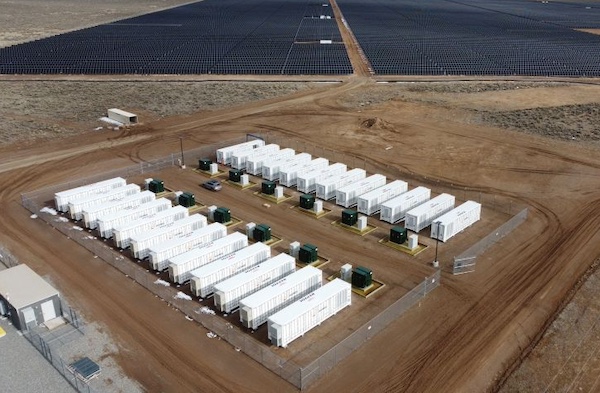
EPC Energy, a premier systems integrator, renewable energy engineering, procurement, and construction firm; has successfully delivered a state-of-the-art 20MW/80MWh solar plus battery energy storage system (BESS). This 20MW/80MWh facility was envisioned as a landmark in the transition to a greener energy future.
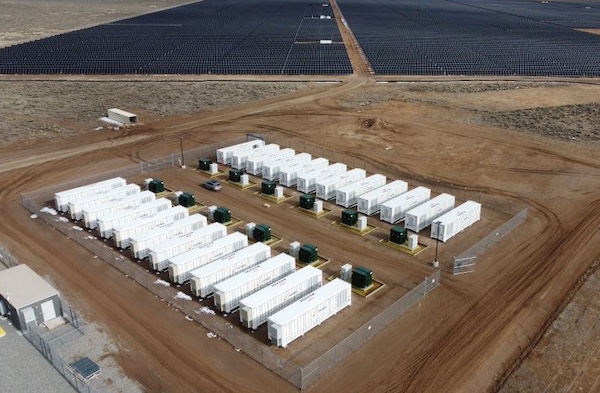
The project featured advanced control systems that ensured optimal energy capture and storage. Predictive analytics and real-time monitoring enhanced overall system efficiency. Implementation of cutting-edge lithium-ion battery technology allowed for high energy density, rapid charge and discharge capabilities, and extended lifecycle. The addition of a cloud-based centralized monitoring system offered unparalleled supervision of battery conditions. Granular cell-level data empowered meticulous commissioning and testing, promptly identifying imbalanced cells in their infancy. Moreover, this system provided real-time project data accessibility through a mobile app, a leap forward in project management. The system showcased its ability to effortlessly control and dispatch over 300 units with diverse power conversion system (PCS) modules and battery ratios. This rapid responsiveness and flexibility set new industry standards.
The commissioning phase was a testament to dedication. It encompassed exhaustive testing, including load testing, battery cycling, and grid synchronization tests. These measures validated the system's performance and reliability. The successful commissioning demonstrated the plant's ability to seamlessly integrate with the SCADA controller, providing reliable power and supporting grid stability. The project's holistic approach encompassed turnkey solutions, ranging from project modeling and design to equipment procurement, supply chain management, installation, and the establishment of a generation resource management system platform. This comprehensive strategy exemplified efficiency and innovation at every turn.
This project serves as a testament to the transformative potential of innovation, advanced technology, and rigorous testing in realizing the vision of a clean and sustainable energy future. The project's ability to harness cloud-based monitoring, control 300 diverse units, and provide turnkey solutions underscores EPC Energy's status as an industry leader. It is more than a solar plus storage energy plant; it is a beacon illuminating the path toward a greener, more sustainable tomorrow.
EPC Energy l https://www.epcenergy.io/

A powerful new film exploring humanity’s profound relationship with water launches on Earth Day, 22 April 2024 in New York City. Produced by the team that brought the award-winning documentary, Brave Blue World to audiences globally, Our Blue World reveals how human agency, ingenuity and community spirit can help rebalance the planet’s water systems.
Actor Liam Neeson voices the narration for Our Blue World, and the stories are told from the perspective of people who have had transformational journeys around water. The movie also looks back to engineering marvels that sustained civilizations for thousands of years, and explores the many ways modern countries are managing water and what they can learn from their ancestors.
Speaking ahead of the film’s release, Neeson said, “It’s incredible, they had it all figured out, we are just rediscovering the water wisdom of our ancestors.”
Paul O’Callaghan, executive producer of Our Blue World explains, “Our Earth is in trouble, and water is the vehicle through which the effects of climate change will be felt. Extreme droughts, floods, fires, loss of biodiversity, pollution and global warming are on the increase. Our Blue World will show that through a small shift in consciousness and practice we can bring enormous positive change and rebalance and regenerate life on earth. The greatest challenge we face in solving the global water crisis is getting people to value water.”
Personal connection
Our Blue World, which is directed by celebrated Irish filmmaker, Ruán Magan, starts with the fundamental idea that - as humans - we already treasure water in many ways. O’Callaghan says the idea for Our Blue World came about while thinking of ways to connect people with the value of water at a very personal level.
“The film stretches out that canvas to include society, culture, mythology, and spirituality. By telling stories that are emotional, relatable, and universal, our goal is to guide viewers to feel a deep personal and cultural identification with water,” he says. “We were delighted and honoured when we received the message that Bono had suggested Your Blue Room for the film. It is one of his all-time favourite U2 songs and a beautiful meditation. The symbolism of Your Blue Room as a metaphor for the planet, Our Blue World, a small intimate place where we all live, influenced the film in many ways, including the choice of the opening David Bowie song which mirrors this image.” adds Paul O’Callaghan.
Filming began in the Andean mountains of Peru with the amunas – a system of ancient, pre-Incan water canals and retention technology. Built by the Wari people, the amunas are being rediscovered and restored today to help bring water into the megacity of Lima.
The story - connecting ancient wisdom and indigenous knowledge with the need for water today - is told by Don Gregorio Rios, a local community advocate and member of the Amunas Brigade. It centers around a colorful festival where people come together to dance, sing and bless and celebrate water, a precious resource in their community.
Reimagining landscapes
The journey continues around the world - to China, where ‘sponge cities’ are mitigating flooding, by transforming cities from grey to green and reimaging the urban landscape. Then to Burundi in East Africa, where hundreds of solar-powered pumps are bringing clean groundwater to over 2.5 million people.
Looking to the future, the filmmakers say, climate change will mainly be felt through extremes of water: too much and too little. The movie asks how we will adapt to a changing water environment, including innovation in products, appliances and techniques that make a resilient, low-carbon water future possible.
“Our ancestors lived in harmony with water,” says O’Callaghan. “They knew that water always wins. Our Blue World will demonstrate how relearning the wisdom of our ancestors, and fusing it with modern science and technology, we can transform this world for the better.”
Production of Our Blue World has been led by the Brave Blue World Foundation and Brave Blue World Studios, with the support from partners the Water Environment Federation (WEF), Backus, brewer Cusqueña, Procter & Gamble, investment specialist Sciens Water, Grundfos and the World Wildlife Fund (WWF). Impact partners are the non-profit water.org, start-up accelerator ImagineH2O, beverage company AB InBev and Yokogawa.
Precious resource
John Ikeda, Chief Mission Officer of the Water Environment Federation (WEF) said, “The 31,000 members of WEF are committed to the stewardship of water, our most precious resource. Building the water workforce and advancing the circular economy for water are our top priorities.
“We’re proud of our long-standing partnership with Brave Blue World Studios and believe that this film will inspire the next generation of water workers to develop innovative new solutions to protect water resources.”
“We are thankful for the opportunity to contribute to this film and to advocate alongside its producers and fellow contributors for the importance of global access to safe water, one of life’s most essential resources,” said Gary White, CEO and co-founder of Water.org and WaterEquity.
Scott Bryan, president of Imagine H2O, said, "As rivers and cultures intertwine, a message of hope emerges: this film unveils the wisdom and possibilities we need to manage water in a changing climate."
Grundfos Group Executive Vice President and Chief Operating Officer, Ulrik Gernow said, "As a leading global pump and water solutions company, we are excited to embark on this journey with Brave Blue World Studios. This partnership reaffirms our dedication to addressing the world's water challenges and to mobilize a movement for a more sustainable and water-secure future for generations to come. As a society, we need to recognize that water holds incredible value for the future of our world but our relationship with water is out of balance and we aim to inspire change to take good care of this precious resource."
Virginie Helias, Chief Sustainability Officer at P&G said, “Water is essential for making and using our products, used by 5 billion worldwide. Our brands are developing innovations that empower people to save water at home while using our products without compromising on performance. Through partnerships like the 50L Home Coalition, we are also leveraging our expertise and consumer insights to create system transformative solutions to water challenges.”
Alexander Loucopoulos, Partner at Sciens Water said, ”As one of the leading investors in water infrastructure, Sciens Water is incredibly proud to be a partner in the making of this groundbreaking documentary. Alongside the Brave Blue World Foundation and all the other movie partners, Sciens Water seeks to raise awareness about global water issues and inspire action towards the multidisciplinary solutions that are ahead of us worldwide.”
WWF Global’s Freshwater Lead, Stuart Orr, said, “Our Blue World is a spectacularly beautiful reminder that water is at the heart of life on Earth and that rivers are our planet’s arteries. It showcases ancient and modern solutions to our worsening water crisis, inspiring us to scale up our efforts and, particularly, to invest in protecting and restoring healthy rivers, which are central to water and food security, tackling climate and nature crises, and driving sustainable development.”
Andre Fourie, Global Vice President of Sustainability at AB InBev says, “As brewers, we understand the precious value of water and the importance of water in shaping local economies and cultures. This documentary highlights the challenges many communities face today tackling issues of water scarcity, but it also showcases some of the solutions and the innovations that are making positive impact. “Collaboration is at the heart of water stewardship, and we believe there are many lessons to take from the partnerships and people caring for the amunas. The amunas may be ancient, but their story is more relevant than ever.”
Steve Hayden, Industry Director at Yokogawa said: "We are honoured to be partnering with Brave Blue World Studios who are taking positive actions to draw the public’s attention to not only the challenges we face in providing safe water but also presenting creative solutions to these problems. This aligns with our company and employee ethos. Co-innovation allows us to come together and reimagine the future for our collective well-being."
Following a premiere in New York City, Brave Blue World Studios will be running a series of premieres around the world, including at Oz Water in Melbourne, Australia; BlueTech Forum in Edinburgh, Scotland; EU Green Week in Brussels, Belgium; WEFTEC 2024 in New Orleans, USA, and Singapore International Water Week. To host a private screening of the film prior to global launch, via on-demand streaming, or learn more about our global education campaign please contact [email protected]
Yokogawa | https://www.yokogawa.com/

The US Environmental Protection Agency and the White House announced $7 billion in funding to bring the benefits of solar to low-income households and disadvantaged communities. The Greenhouse Gas Reduction Fund Solar for All funding awards are a flagship component of the Inflation Reduction Act, heralded as a generational opportunity to fundamentally shift the clean energy market and create long-term savings and wealth-building opportunities for people who have historically been excluded from access to renewable energy.
Clean Energy Group is thrilled to be a Solar for All awardee, as a partner organization in the Community Power Coalition, led by Inclusive Prosperity Capital (IPC). The Community Power Coalition is a multi-state coalition focused on increasing capacity and deployment of mission-driven, community-based solar developers. Clean Energy Group will provide technical assistance related to deploying community solar paired with battery storage, with an emphasis on delivering cost-savings to low-income households and energy resilience to underserved communities. Read a press release from IPC on this funding announcement here.
“For vulnerable households that depend on electricity for their health and security, the solar and battery storage systems resulting from Solar for All could act as a literal lifeline during times of emergency,” said Marriele Mango, project director for Clean Energy Group’s energy resilience initiatives. “Through our participation in the Community Power Coalition, Clean Energy Group is excited to support community-led resilient power installations that improve health outcomes, increase energy security, and reduce energy burdens, while creating a more reliable and resilient grid.”
“Solar for All is a transformational opportunity to expand on work that Clean Energy Group has been championing for over a decade,” said Clean Energy Group President and Executive Director Seth Mullendore. “As a member of the Community Power Coalition, we will continue our work with community-based partners in marginalized communities, where we have advanced solar and battery storage development at over 300 community-serving facilities across 32 states and Puerto Rico.”
Earth Day 2024 is a celebratory moment for the entire clean energy field. Clean Energy Group congratulates all of the Solar for All awardees and applicants for their hard work and dedication to building a strong, equitable, and inclusive clean energy future.
Clean Energy Group | www.cleanegroup.org
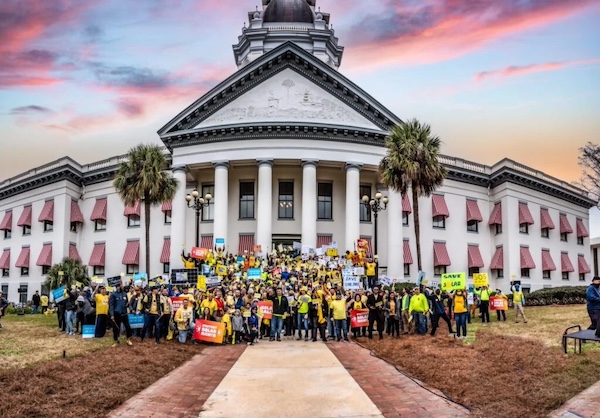
Solar United Neighbors, a national nonprofit that educates consumers about solar energy and helps them go solar, applauds the Environmental Protection Agency (EPA) for announcing funding for its Solar for All program. Solar for All will help hundreds of thousands of new low-to-moderate income families benefit from solar energy.
$7 billion investment from the EPA’s Solar for All program will help expand solar access
The Solar for All Program is awarding up to 60 grants to states, territories, Tribal governments, municipalities, and nonprofits. These awards expand the number of people that can benefit from solar energy. Funding for Solar for All comes from the Inflation Reduction Act.
“We’re ready to get to work,” said Anya Schoolman, Executive Director, Solar United Neighbors. “This investment will help more families save money and take control of where their energy comes from.”
Solar United Neighbors is a national leader in designing programs to expand solar access. It pioneered the first Solar for All program in Washington, D.C. in 2017. That effort helped 73 families go solar. It has developed more than two dozen such programs over the past seven years.
Solar United Neighbors will work on this with local partners in more than a dozen states.
The families who will participate in Solar for All are the ones likeliest to have the highest energy burden. Their energy bill takes a larger percentage of their income than it does for higher income families. Going solar is a great way for them to lower their energy costs.
Solar United Neighbors | https://www.solarunitedneighbors.org/
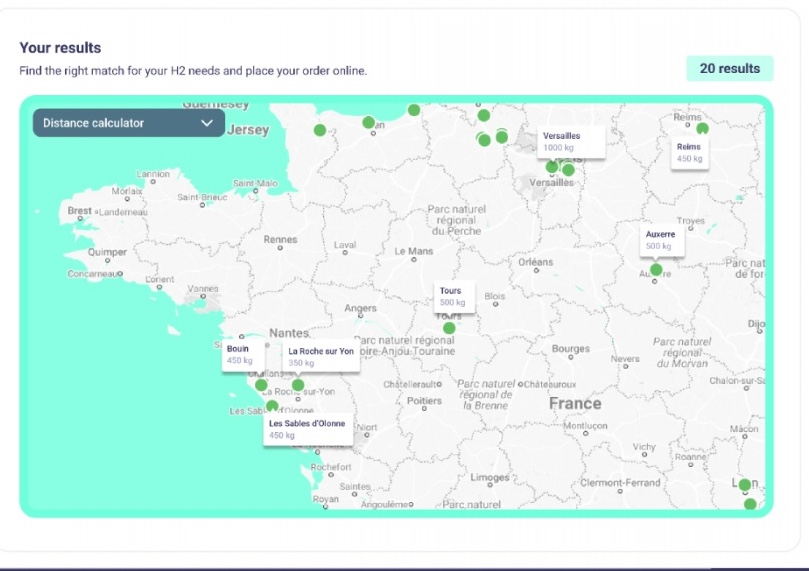
Lhyfe (EURONEXT: LHYFE), a world pioneer in the production of green and renewable hydrogen, announces the launch of the first Green Hydrogen Marketplace, on its online portal Lhyfe Heroes. Since 2017, Lhyfe has been working to accelerate decarbonisation through major innovations that are transforming, greening and modernising the hydrogen industry, such as the world’s first industrial-scale green hydrogen production site directly connected to a wind farm in 2021, the world’s first pilot platform for producing green hydrogen at sea in 2022, and the digitalisation of the sector, since 2022, with the Heroes digital platform whose flagship service is now the Marketplace.
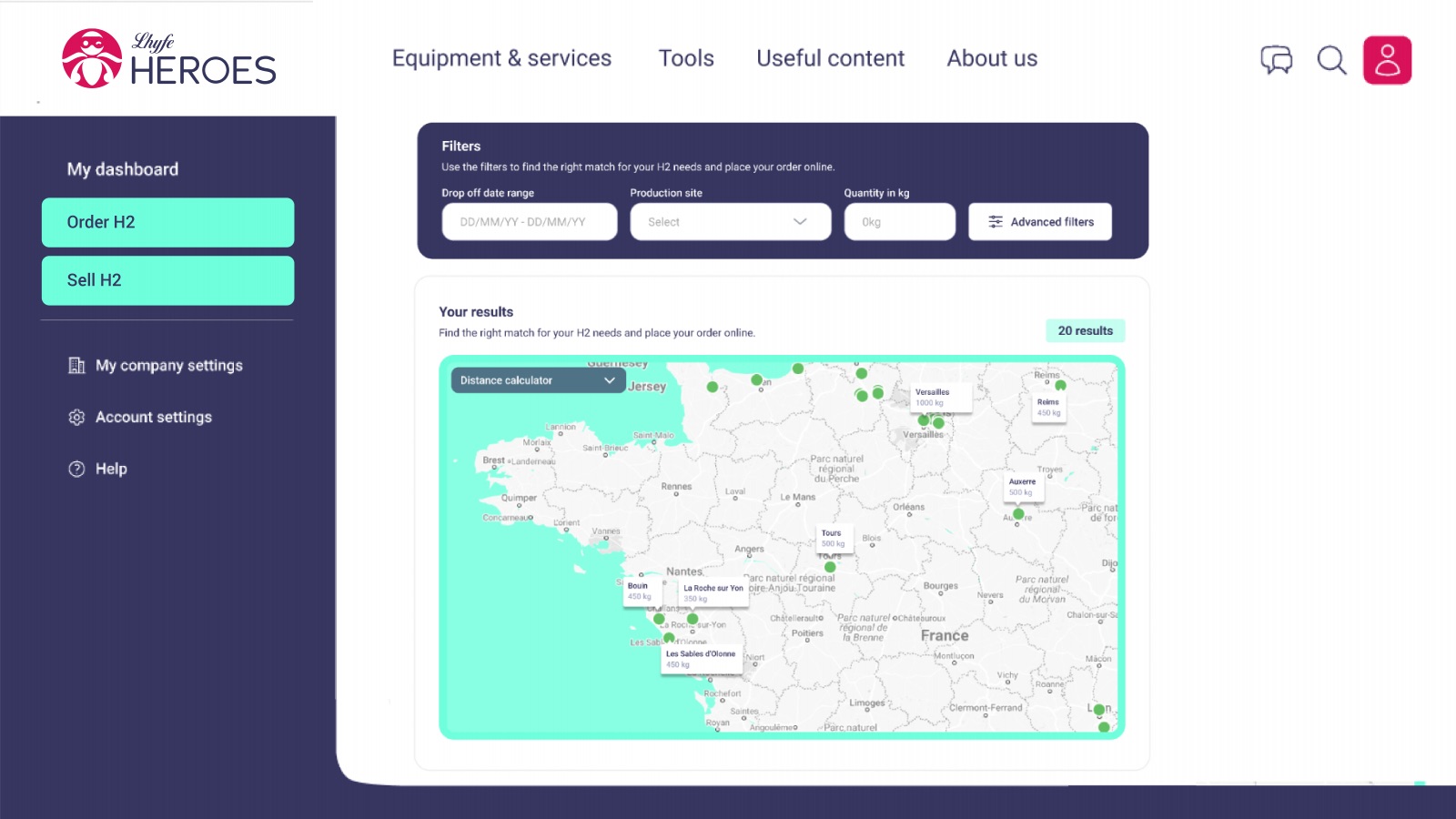
Using digital to facilitate the buying and selling of green hydrogen by coordinating players in the sector
Green hydrogen is one of the levers for decarbonising industry and transport. Every day, Lhyfe strives to make it accessible to as many people as possible, to provide significant decarbonisation leverage to industry and mobility. But while producers, projects and uses are beginning to emerge across Europe, the industry is still using fairly traditional tools. In all sectors, digitalisation has been a decisive lever for modernisation and acceleration.
In 2022, Lhyfe launched the first building blocks of Heroes, the first digital platform for green hydrogen. This was the first step in digitalising the sector, and it has since been regularly enhanced with new services. By launching the Green Hydrogen Marketplace today, Lhyfe is bringing producers and consumers closer together and facilitating access to this clean gas.
Beyond digitalization, in a rapidly developing sector, the first phase of this marketplace will enable buyers with their own hydrogen transport solutions and producers to cooperate to strengthen the “green hydrogen” offer across Europe:
- Better regional coverage: To meet the needs of customers wherever they are, while optimising hydrogen transport and the associated logistics costs, thanks to a network of green-certified production sites throughout Europe.
- A growing choice of supply sources: Access to an increasingly wide range of products and services to meet a one-off increase in needs.
- Production optimisation: To make any surplus production available, anticipate a maintenance operation, etc.
- Guaranteed Green: All the hydrogen available on the Marketplace is and will be guaranteed green by Lhyfe's experts.
Eventually, the Marketplace will be available to all hydrogen buyers requiring delivery (fuel stations, logistics centres, etc.). Many more features will be added in the coming weeks and months.
Around ten partners already in the first deployment phase
Interested users can register on the platform to request the creation of their account. Privately negotiated commercial terms are shared only between the seller and the buyer. The first version of the platform is free. The Marketplace already has around ten partners, including other green hydrogen producers.
Antoine Hamon, Director of Operations at Lhyfe: “We first developed this tool internally, to boost our own efficiency and optimise our multi-site management, and then we offered it to other players in the sector. In just a few clicks, on a single map, we can see the different supply points and useful information for choosing the date and source. This saves time for both buyers and sellers. This marketplace opens up new opportunities for us to optimise our production sites and give our customers greater guarantees in terms of the availability of green hydrogen”.
Lhyfe | https://www.lhyfe.com/
Matthieu Guesné, Lhyfe’s founder and CEO: “The digitalisation of the sector has always been one of Lhyfe's projects. We developed the algorithmic part and remote control methods to optimise our production. The Heroes platform then enabled many players in the mobility sector to gain a better understanding of this sector and to structure their projects ... and today we are very proud to be launching the first green Hydrogen Marketplace. In the industry, we are all convinced that it is by joining forces to offer an increasingly abundant supply that we will accelerate the transition to green hydrogen. The Marketplace is a new step in accelerating our decarbonisation!”
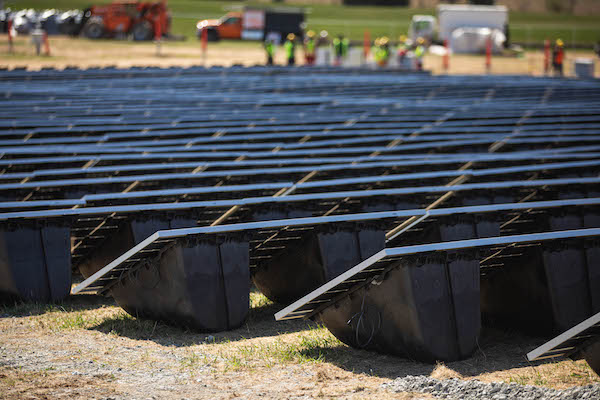
Alternative Energies May 15, 2023
The United States is slow to anger, but relentlessly seeks victory once it enters a struggle, throwing all its resources into the conflict. “When we go to war, we should have a purpose that our people understand and support,” as former Secretary ....

Unleashing trillions of dollars for a resilient energy future is within our grasp — if we can successfully navigate investment risk and project uncertainties.
The money is there — so where are the projects?
A cleaner and more secure energy future will depend on tapping trillions of dollars of capital. The need to mobilize money and markets to enable the energy transition was one of the key findings of one of the largest studies ever conducted among the global energy sector C-suite. This will mean finding ways to reduce the barriers and uncertainties that prevent money from flowing into the projects and technologies that will transform the energy system. It will also mean fostering greater collaboration and alignment among key players in the energy space.
 Interestingly, the study found that insufficient access to finance was not considered the primary cause of the current global energy crisis. In fact, capital was seen to be available — but not being unlocked. Why is that? The answer lies in the differing risk profiles of energy transition investments around the world. These risks manifest in multiple ways, including uncertainties relating to project planning, public education, stakeholder engagement, permitting, approvals, policy at national and local levels, funding and incentives, technology availability, and supply chains.
Interestingly, the study found that insufficient access to finance was not considered the primary cause of the current global energy crisis. In fact, capital was seen to be available — but not being unlocked. Why is that? The answer lies in the differing risk profiles of energy transition investments around the world. These risks manifest in multiple ways, including uncertainties relating to project planning, public education, stakeholder engagement, permitting, approvals, policy at national and local levels, funding and incentives, technology availability, and supply chains.
These risks need to be addressed to create more appealing investment opportunities for both public and private sector funders. This will require smart policy and regulatory frameworks that drive returns from long-term investment into energy infrastructure. It will also require investors to recognize that resilient energy infrastructure is more than an ESG play — it is a smart investment in the context of doing business in the 21st century.
Make de-risking investment profiles a number one priority
According to the study, 80 percent of respondents believe the lack of capital being deployed to accelerate the transition is the primary barrier to building the infrastructure required to improve energy security. At the same time, investors are looking for opportunities to invest in infrastructure that meets ESG and sustainability criteria. This suggests an imbalance between the supply and demand of capital for energy transition projects.
How can we close the gap?
One way is to link investors directly to energy companies. Not only would this enable true collaboration and non-traditional partnerships, but it would change the way project financing is conceived and structured — ultimately aiding in potentially satisfying the risk appetite of latent but hugely influential investors, such as pension funds. The current mismatch of investor appetite and investable projects reveals a need for improving risk profiles, as well as a mindset shift towards how we bring investment and developer stakeholders together for mutual benefit. The circular dilemma remains: one sector is looking for capital to undertake projects within their skill to deploy, while another sector wonders where the investable projects are.
This conflict is being played out around the world; promising project announcements are made, only to be followed by slow progress (or no action at all). This inertia results when risks are compounded and poorly understood. To encourage collaboration between project developers and investors with an ESG focus, more attractive investment opportunities can be created by pulling several levers: public and private investment strategies, green bonds and other sustainable finance instruments, and innovative financing models such as impact investing.

Expedite permitting to speed the adoption of new technologies
Another effective strategy to de-risk investment profiles is found in leveraging new technologies and approaches that reduce costs, increase efficiency, and enhance the reliability of energy supply. Research shows that 62 percent of respondents indicated a moderate or significant increase in investment in new and transitional technologies respectively, highlighting the growing interest in innovative solutions to drive the energy transition forward.
Hydrogen, carbon capture and storage, large-scale energy storage, and smart grids are some of the emerging technologies identified by survey respondents as having the greatest potential to transform the energy system and create new investment opportunities. However, these technologies face challenges such as long lag times between conception and implementation.
If the regulatory environment makes sense, then policy uncertainty is reduced, and the all-important permitting pathways are well understood and can be navigated. Currently, the lack of clear, timely, and fit-for-purpose permitting is a major roadblock to the energy transition. To truly unleash the potential of transitional technologies requires the acceleration of regulatory systems that better respond to the nuance and complexity of such technologies (rather than the current one-size-fits all approach). In addition, permitting processes must also be expedited to dramatically decrease the period between innovation, commercialization, and implementation. One of the key elements of faster permitting is effective consultation with stakeholders and engagement with communities where these projects will be housed for decades. This is a highly complex area that requires both technical and communication skills.
The power of collaboration, consistency, and systems thinking
The report also reveals the need for greater collaboration among companies in the energy space to build a more resilient system. The report shows that, in achieving net zero, there is a near-equal split between those increasing investment (47 percent of respondents), and those decreasing investment (39 percent of respondents). This illustrates the complexity and diversity of the system around the world. A more resilient system will require all its components – goals and actions – to be aligned towards a common outcome.
Another way to de-risk the energy transition is to establish consistent, transparent, and supportive policy frameworks that encourage investment and drive technological innovation. The energy transition depends on policy to guide its direction and speed by affecting how investors feel and how the markets behave. However, inconsistent or inadequate policy can also be a source of uncertainty and instability. For example, shifting political priorities, conflicting international standards, and the lack of market-based mechanisms can hinder the deployment of sustainable technologies, resulting in a reluctance to commit resources to long-term projects.
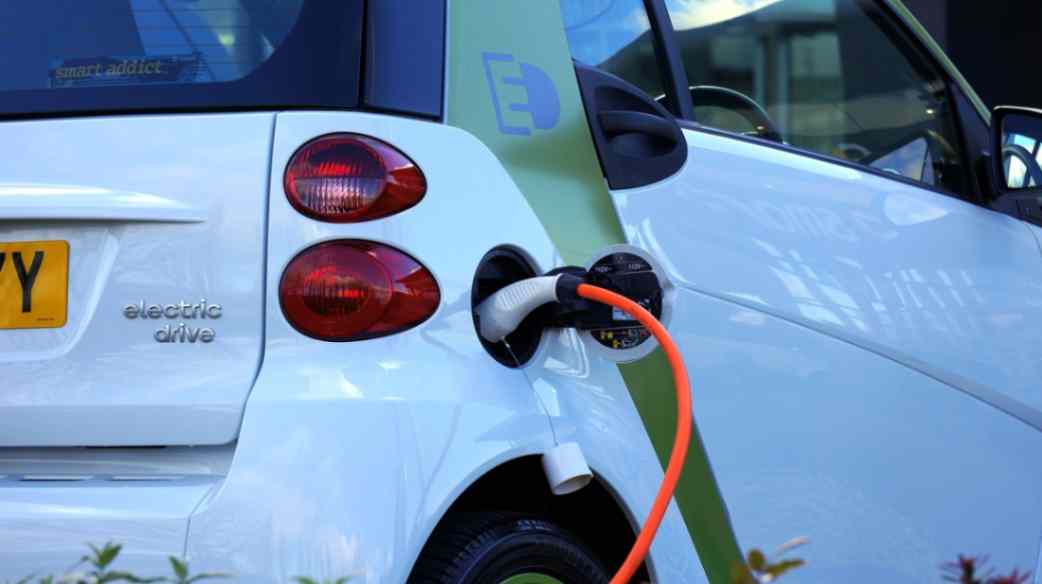
Variations in country-to-country deployment creates disparities in energy transition progress. For instance, the 2022 Inflation Reduction Act in the US has posed challenges for the rest of the world, by potentially channeling energy transition investment away from other markets and into the US. This highlights the need for a globally unified approach to energy policy that balances various national interests while addressing a global problem.
To facilitate the energy transition, it is imperative to establish stable, cohesive, and forward-looking policies that align with global goals and standards. By harmonizing international standards, and providing clear and consistent signals, governments and policymakers can generate investor confidence, helping to foster a robust energy ecosystem that propels the sector forward.
Furthermore, substantive and far-reaching discussions at international events like the United Nations Conference of the Parties (COP), are essential to facilitate this global alignment. These events provide an opportunity to de-risk the energy transition through consistent policy that enables countries to work together, ensuring that the global community can tackle the challenges and opportunities of the energy transition as a united front.
Keeping net-zero ambitions on track
Despite the challenges faced by the energy sector, the latest research reveals a key positive: 91 percent of energy leaders surveyed are working towards achieving net zero. This demonstrates a strong commitment to the transition and clear recognition of its importance. It also emphasizes the need to accelerate our efforts, streamline processes, and reduce barriers to realizing net-zero ambitions — and further underscores the need to de-risk energy transition investment by removing uncertainties.
The solution is collaborating and harmonizing our goals with the main players in the energy sector across the private and public sectors, while establishing consistent, transparent, and supportive policy frameworks that encourage investment and drive technological innovation.
These tasks, while daunting, are achievable. They require vision, leadership, and action from all stakeholders involved. By adopting a new mindset about how we participate in the energy system and what our obligations are, we can stimulate the rapid progress needed on the road to net zero.
Dr. Tej Gidda (Ph.D., M.Sc., BSc Eng) is an educator and engineer with over 20 years of experience in the energy and environmental fields. As GHD Global Leader – Future Energy, Tej is passionate about moving society along the path towards a future of secure, reliable, and affordable low-carbon energy. His focus is on helping public and private sector clients set and deliver on decarbonization goals in order to achieve long-lasting positive change for customers, communities, and the climate. Tej enjoys fostering the next generation of clean energy champions as an Adjunct Professor at the University of Waterloo Department of Civil and Environmental Engineering.
GHD | www.ghd.com
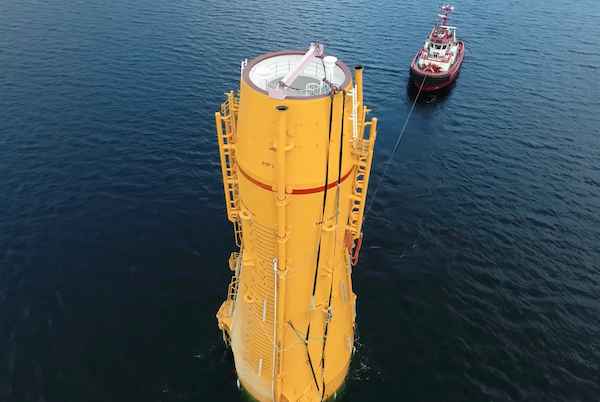
The Kincardine floating wind farm, located off the east coast of Scotland, was a landmark development: the first commercial-scale project of its kind in the UK sector. Therefore, it has been closely watched by the industry throughout its installation. With two of the turbines now having gone through heavy maintenance, it has also provided valuable lessons into the O&M processes of floating wind projects.
In late May, the second floating wind turbine from the five-turbine development arrived in the port of Massvlakte, Rotterdam, for maintenance. An Anchor Handling Tug Supply (AHTS)
vessel was used to deliver the KIN-02 turbine two weeks after a Platform Supply Vessel (PSV) and AHTS had worked to disconnect the turbine from the wind farm site. The towing vessel became the third vessel used in the operation.
This is not the first turbine disconnected from the site and towed for maintenance. In the summer of 2022, KIN-03 became the world’s first-ever floating wind turbine that required heavy maintenance (i.e. being disconnected and towed for repair). It was also towed from Scotland to Massvlakte.
Each of these operations has provided valuable lessons for the ever-watchful industry in how to navigate the complexities of heavy maintenance in floating wind as the market segment grows.

The heavy maintenance process
When one of Kincardine’s five floating 9.5 MW turbines (KIN-03) suffered a technical failure in May 2022, a major technical component needed to be replaced. The heavy maintenance strategy selected by the developer and the offshore contractors consisted in disconnecting and towing the turbine and its floater to Rotterdam for maintenance, followed by a return tow and re-connection. All of the infrastructure, such as crane and tower access, remained at the quay following the construction phase. (Note, the following analysis only covers KIN-03, as details of the second turbine operation are not yet available).
Comparing the net vessel days for both the maintenance and the installation campaigns at this project highlights how using a dedicated marine spread can positively impact operations.
For this first-ever operation, a total of 17.2 net vessel days were required during turbine reconnection—only a slight increase on the 14.6 net vessel days that were required for the first hook-up operation performed during the initial installation in 2021. However, it exceeds the average of eight net vessel days during installation. The marine spread used in the heavy maintenance operation differed from that used during installation. Due to this, it did not benefit from the learning curve and experience gained throughout the initial installation, which ultimately led to the lower average vessel days.
The array cable re-connection operation encountered a similar effect. The process was performed by one AHTS that spent 10 net vessel days on the operation. This compares to the installation campaign, where the array cable second-end pull-in lasted a maximum of 23.7 hours using a cable layer.
Overall, the turbine shutdown duration can be broken up as 14 days at the quay for maintenance, 52 days from turbine disconnection to turbine reconnection, and 94 days from disconnection to the end of post-reconnection activities.
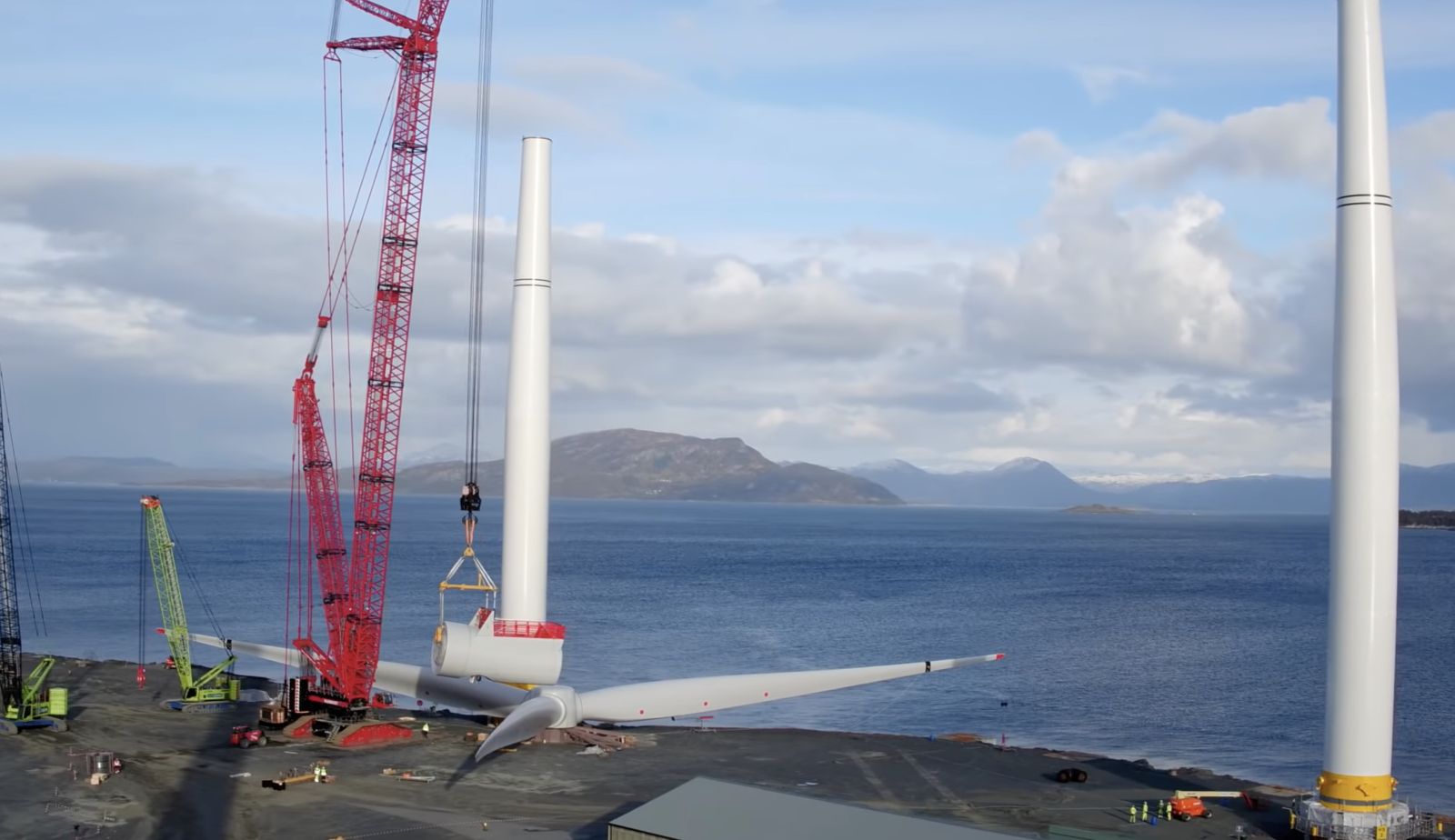
What developers should keep in mind for heavy maintenance operations
This analysis has uncovered two main lessons developers should consider when planning a floating wind project: the need to identify an appropriate O&M port, and to guarantee that a secure fleet is available.
Floating wind O&M operations require a port with both sufficient room and a deep-water quay. The port must also be equipped with a heavy crane with sufficient tip height to accommodate large floaters and reach turbine elevation. Distance to the wind farm should also be taken into account, as shorter distances will reduce towing time and, therefore, minimize transit and non-productive turbine time.
During the heavy maintenance period for KIN-03 and KIN-02, the selected quay (which had also been utilized in the initial installation phase of the wind farm project), was already busy as a marshalling area for other North Sea projects. This complicated the schedule significantly, as the availability of the quay and its facilities had to be navigated alongside these other projects. This highlights the importance of abundant quay availability both for installation (long-term planning) and maintenance that may be needed on short notice.
At the time of the first turbine’s maintenance program (June 2022), the North Sea AHTS market was in an exceptional situation: the largest bollard pull AHTS units contracted at over $200,000 a day, the highest rate in over a decade.
During this time, the spot market was close to selling out due to medium-term commitments, alongside the demand for high bollard pull vessels for the installation phase at a Norwegian floating wind farm project. The Norwegian project required the use of four AHTS above a 200t bollard pull. With spot rates ranging from $63,000 to $210,000 for the vessels contracted for Kincardine’s maintenance, the total cost of the marine spread used in the first repair campaign was more than $4 million.
Developers should therefore consider the need to structure maintenance contracts with AHTS companies, either through frame agreements or long-term charters, to decrease their exposure to spot market day rates as the market tightens in the future.

While these lessons are relevant for floating wind developers now, new players are looking towards alternative heavy O&M maintenance options for the future. Two crane concepts are especially relevant in this instance. The first method is for a crane to be included in the turbine nacelle to be able to directly lift the component which requires repair from the floater, as is currently seen on onshore turbines. This method is already employed in onshore turbines and could be applicable for offshore. The second method is self-elevating cranes with several such solutions already in development.
The heavy maintenance operations conducted on floating turbines at the Kincardine wind farm have provided invaluable insights for industry players, especially developers. The complex process of disconnecting and towing turbines for repairs highlights the need for meticulous planning and exploration of alternative maintenance strategies, some of which are already in the pipeline. As the industry evolves, careful consideration of ports, and securing fleet contracts, will be crucial in driving efficient and cost-effective O&M practices for the floating wind market.
Sarah McLean is Market Research Analyst at Spinergie, a maritime technology company specializing in emission, vessel performance, and operation optimization.
Spinergie | www.spinergie.com

According to the Energy Information Administration (EIA), developers plan to add 54.5 gigawatts (GW) of new utility-scale electric generating capacity to the U.S. power grid in 2023. More than half of this capacity will be solar. Wind power and battery storage are expected to account for roughly 11 percent and 17 percent, respectively.
A large percentage of new installations are being developed in areas that are prone to extreme weather events and natural disasters (e.g., Texas and California), including high wind, tornadoes, hail, flooding, earthquakes, wildfires, etc. With the frequency and severity of many of these events increasing, project developers, asset owners, and tax equity partners are under growing pressure to better understand and mitigate risk.
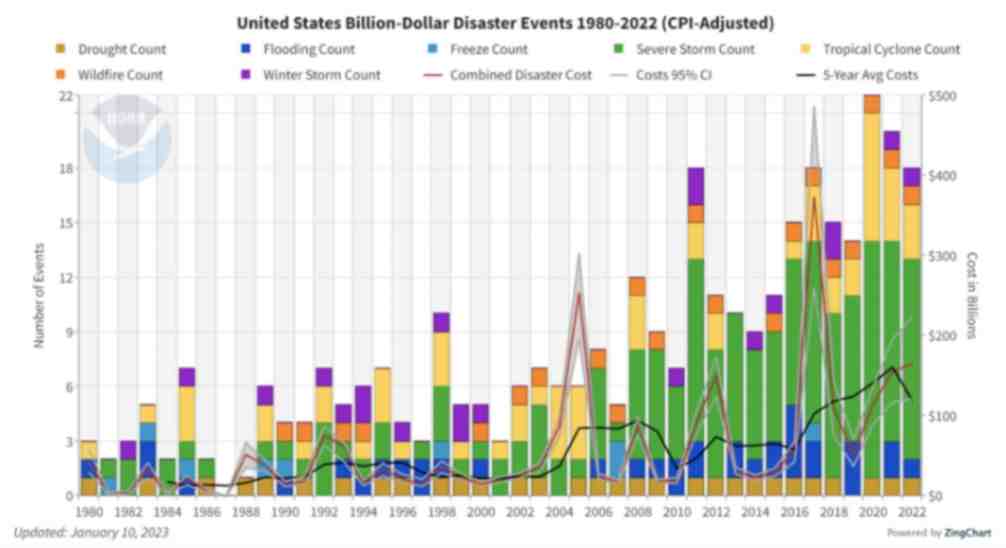
Figure 1. The history of billion-dollar disasters in the United States each year from 1980 to 2022 (source: NOAA)
In terms of loss prevention, a Catastrophe (CAT) Modeling Study is the first step to understanding the exposure and potential financial loss from natural hazards or extreme weather events. CAT studies form the foundation for wider risk management strategies, and have significant implications for insurance costs and coverage.
Despite their importance, developers often view these studies as little more than a formality required for project financing. As a result, they are often conducted late in the development cycle, typically after a site has been selected. However, a strong case can be made for engaging early with an independent third party to perform a more rigorous site-specific technical assessment. Doing so can provide several advantages over traditional assessments conducted by insurance brokerage affiliates, who may not possess the specialty expertise or technical understanding needed to properly apply models or interpret the results they generate. One notable advantage of early-stage catastrophe studies is to help ensure that the range of insurance costs, which can vary from year to year with market forces, are adequately incorporated into the project financial projections.
The evolving threat of natural disasters
Over the past decade, the financial impact of natural hazard events globally has been almost three trillion dollars. In the U.S. alone, the 10-year average annual cost of natural disaster events exceeding $1 billion increased more than fourfold between the 1980s ($18.4 billion) and the 2010s ($84.5 billion).

Investors, insurers, and financiers of renewable projects have taken notice of this trend, and are subsequently adapting their behavior and standards accordingly. In the solar market, for example, insurance premiums increased roughly four-fold from 2019 to 2021. The impetus for this increase can largely be traced back to a severe storm in Texas in 2019, which resulted in an $80 million loss on 13,000 solar panels that were damaged by hail.
The event awakened the industry to the hazards severe storms present, particularly when it comes to large-scale solar arrays. Since then, the impact of convective weather on existing and planned installations has been more thoroughly evaluated during the underwriting process. However, far less attention has been given to the potential for other natural disasters; events like floods and earthquakes have not yet resulted in large losses and/or claims on renewable projects (including wind farms). The extraordinary and widespread effect of the recent Canadian wildfires may alter this behavior moving forward.
A thorough assessment, starting with a CAT study, is key to quantifying the probability of their occurrence — and estimating potential losses — so that appropriate measures can be taken to mitigate risk.
All models are not created equal
Industrywide, certain misconceptions persist around the use of CAT models to estimate losses from an extreme weather event or natural disaster.
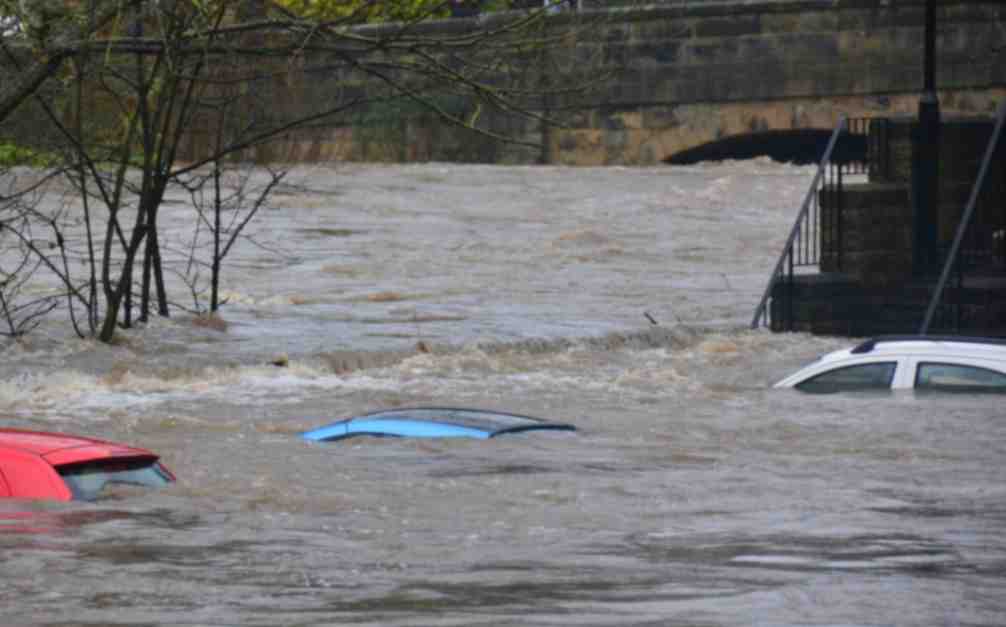
Often, the perception is that risk assessors only need a handful of model inputs to arrive at an accurate figure, with the geographic location being the most important variable. While it’s true that many practitioners running models will pre-specify certain project characteristics regardless of the asset’s design (for example, the use of steel moment frames without trackers for all solar arrays in a given region or state), failure to account for even minor details can lead to loss estimates that are off by multiple orders of magnitude.
The evaluation process has recently become even more complex with the addition of battery energy storage. Relative to standalone solar and wind farms, very little real-world experience and data on the impact of extreme weather events has been accrued on these large-scale storage installations. Such projects require an even greater level of granularity to help ensure that all risks are identified and addressed.
Even when the most advanced modeling software tools are used (which allow for thousands of lines of inputs), there is still a great deal that is subject to interpretation. If the practitioner does not possess the expertise or technical ability needed to understand the model, the margin for error can increase substantially. Ultimately, this can lead to overpaying for insurance. Worse, you may end up with a policy with insufficient coverage. In both cases, the profitability of the asset is impacted.
Supplementing CAT studies
In certain instances, it may be necessary to supplement CAT models with an even more detailed analysis of the individual property, equipment, policies, and procedures. In this way, an unbundled risk assessment can be developed that is tailored to the project. Supplemental information (site-specific wind speed studies and hydrological studies, structural assessment, flood maps, etc.) can be considered to adjust vulnerability models.
This provides an added layer of assurance that goes beyond the pre-defined asset descriptions in the software used by traditional studies or assessments. By leveraging expert elicitations, onsite investigations, and rigorous engineering-based methods, it is possible to discretely evaluate asset-specific components as part of the typical financial loss estimate study: this includes Normal Expected Loss (NEL), also known as Scenario Expected Loss (SEL); Probable Maximum Loss (PML), also known as Scenario Upper Loss (SUL); and Probabilistic Loss (PL).
Understanding the specific vulnerabilities and consequences can afford project stakeholders unique insights into quantifying and prioritizing risks, as well as identifying proper mitigation recommendations.
Every project is unique
The increasing frequency and severity of natural disasters and extreme weather events globally is placing an added burden on the renewable industry, especially when it comes to project risk assessment and mitigation. Insurers have signaled that insurance may no longer be the main basis for transferring risk; traditional risk management, as well as site and technology selection, must be considered by developers, purchasers, and financiers.
As one of the first steps in understanding exposure and the potential capital loss from a given event, CAT studies are becoming an increasingly important piece of the risk management puzzle. Developers should treat them as such by engaging early in the project lifecycle with an independent third-party practitioner with the specialty knowledge, tools, and expertise to properly interpret models and quantify risk.
Hazards and potential losses can vary significantly depending on the project design and the specific location. Every asset should be evaluated rigorously and thoroughly to minimize the margin for error, and maximize profitability over its life.
 Chris LeBoeuf is Global Head of the Extreme Loads and Structural Risk division of ABS Group, based in San Antonio, Texas. He leads a team of more than 60 engineers and scientists in the US, UK, and Singapore, specializing in management of risks to structures and equipment related to extreme loading events, including wind, flood, seismic and blast. Chris has more than 20 years of professional experience as an engineering consultant, and is a recognized expert in the study of blast effects and blast analysis, as well as design of buildings. He holds a Bachelor of Science in Civil Engineering from The University of Texas at San Antonio, and is a registered Professional Engineer in 12 states.
Chris LeBoeuf is Global Head of the Extreme Loads and Structural Risk division of ABS Group, based in San Antonio, Texas. He leads a team of more than 60 engineers and scientists in the US, UK, and Singapore, specializing in management of risks to structures and equipment related to extreme loading events, including wind, flood, seismic and blast. Chris has more than 20 years of professional experience as an engineering consultant, and is a recognized expert in the study of blast effects and blast analysis, as well as design of buildings. He holds a Bachelor of Science in Civil Engineering from The University of Texas at San Antonio, and is a registered Professional Engineer in 12 states.
ABS Group | www.abs-group.com
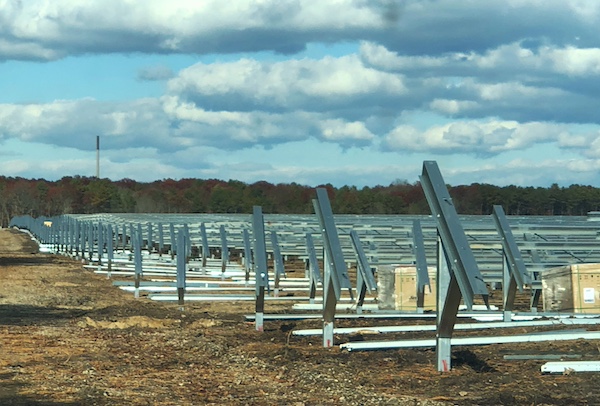
Throughout my life and career as a real estate developer in New York City, I’ve had many successes. In what is clearly one of my most unusual development projects in a long career filled with them, I initiated the building of a solar farm to help t....

I’m just going to say it, BIPV is dumb. Hear me out…. Solar is the most affordable form of energy that has ever existed on the planet, but only because the industry has been working towards it for the past 15 years. Governments,....
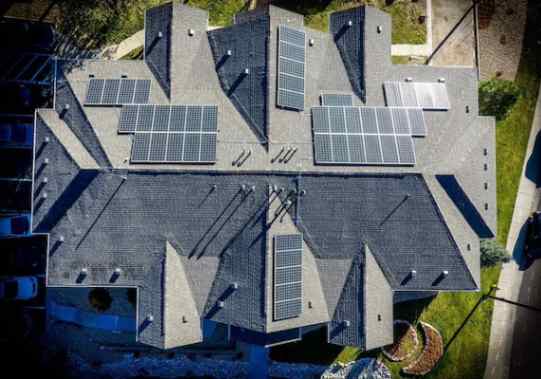
Heat waves encircled much of the earth last year, pushing temperatures to their highest in recorded history. The water around Florida was “hot-tub hot” — topping 101° and bleaching and killing coral in waters around the peninsula. Phoenix had ....
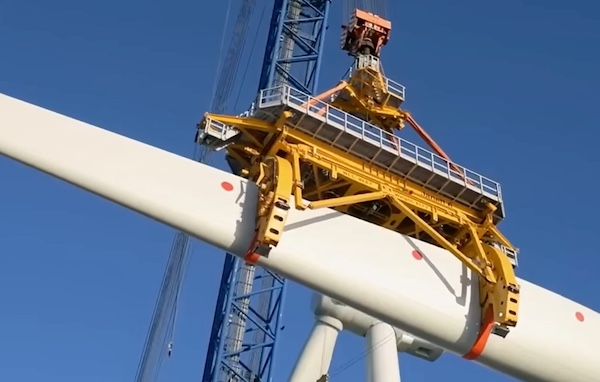
Wind turbines play a pivotal role in the global transition to sustainable energy sources. However, the harsh environmental conditions in which wind turbines operate, such as extreme temperatures, high humidity, and exposure to various contaminants, p....

Wind energy remains the leading non-hydro renewable technology, and one of the fastest-growing of all power generation technologies. The key to making wind even more competitive is maximizing energy production and efficiently maintaining the assets. ....
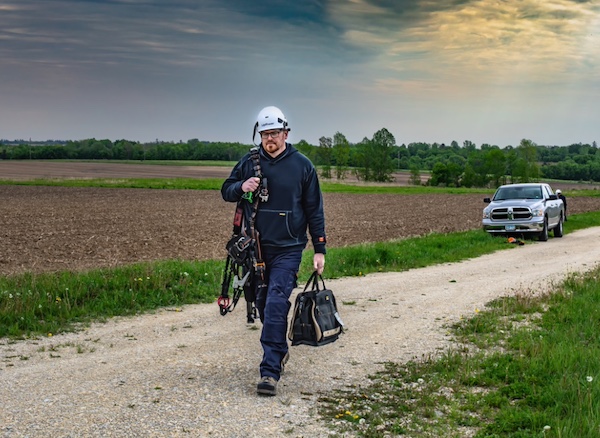
The allure of wind turbines is undeniable. For those fortunate enough to visit these engineering marvels, it’s an experience filled with awe and learning. However, the magnificence of these structures comes with inherent risks, making safety an abs....
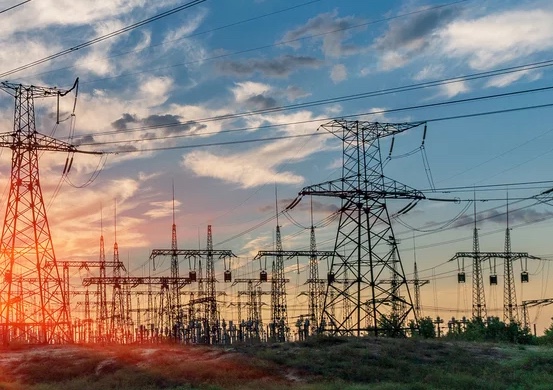
Battery energy storage is a critical technology to reducing our dependence on fossil fuels and build a low carbon future. Renewable energy generation is fundamentally different from traditional fossil fuel energy generation in that energy cannot be p....
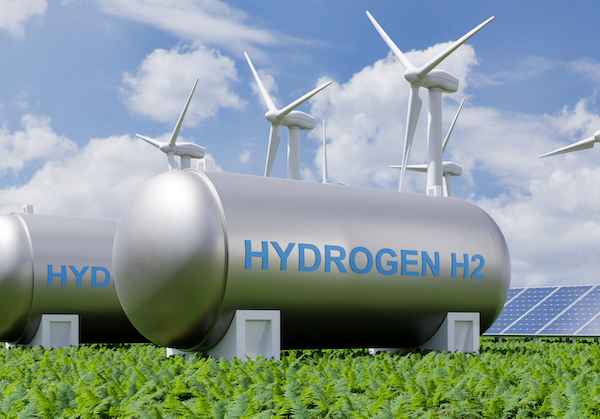
Not enough people know that hydrogen fuel cells are a zero-emission energy technology. Even fewer know water vapor's outsized role in electrochemical processes and reactions. Producing electricity through a clean electrochemical process with water....

In the ever-evolving landscape of sustainable transportation, a ground-breaking shift is here: 2024 ushers in a revolutionary change in Electric Vehicle (EV) tax credits in the United States. Under the Inflation Reduction Act (IRA), a transforma....

Now more than ever, it would be difficult to overstate the importance of the renewable energy industry. Indeed, it seems that few other industries depend as heavily on constant and rapid innovation. This industry, however, is somewhat unique in its e....

University of Toronto’s latest student residence welcomes the future of living with spaces that are warmed by laptops and shower water. In September 2023, one of North America’s largest residential passive homes, Harmony Commons, located....

For decades, demand response (DR) has proven a tried-and-true conservation tactic to mitigate energy usage during peak demand hours. Historically, those peak demand hours were relatively predictable, with increases in demand paralleling commuter and ....